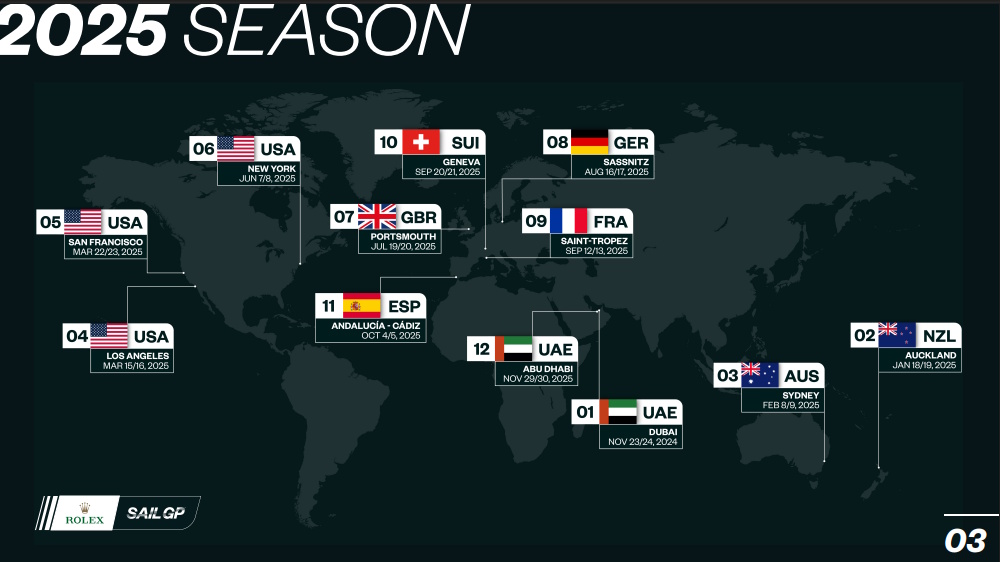The History and Speed Evolution of the F50 Catamaran
The F50 catamaran is a marvel of modern sailing—a vessel that has not only redefined the limits of speed on water but also transformed the spectacle of competitive sailing.
Since its debut in 2019, the F50 has been at the heart of the SailGP series, thrilling fans with its blend of cutting-edge technology and breathtaking performance.

Origins: From AC50 to F50
The F50’s story begins with the AC50 catamarans used in the 2017 America’s Cup in Bermuda. After the Cup, three AC50s were converted and three new boats were built to create the initial SailGP fleet.
The F50 was designed as a one-design class, meaning all teams race with identical boats, ensuring that victory comes down to skill, strategy, and teamwork rather than technological advantage.
While the F50 shares its DNA with the AC50, it is a fundamentally different beast. The transformation included:
Advanced control systems: The F50 introduced electric motors and lithium-ion batteries to power hydraulics, replacing two of the traditional grinders and allowing for more precise, responsive control.
Modular wingsails: The F50 features modular wings that can be adjusted in height (between 18 and 24 meters, with even larger wings in development), adapting to varying wind conditions for optimal performance.
Improved foils: The biggest leap came with the foiling technology—appendages that lift the hull above the water, drastically reducing drag and unlocking new speed records.

Early Speed Records and Technological Refinement
At launch, the F50 was already among the fastest sailboats ever built. Early predictions and demonstrations suggested top speeds approaching 50 knots (92.6 km/h). In the first SailGP seasons, teams regularly pushed the boats past this threshold, with the first official race speeds exceeding 92.6 km/h.
The initial focus was on reliability and control. Early F50s were challenging to handle, but as teams and engineers refined the systems, the boats became more stable and easier to push to their limits. The addition of advanced sensors—collecting up to 30,000 data points in real time—helped crews fine-tune their strategies and performance.
Chasing 100 km/h: The Evolution of Top Speed

Breaking the 100 km/h barrier became an obsession within SailGP. The F50’s design team and sailors knew the boat had the potential, but it would require incremental innovation and perfect conditions.
Key Innovations Driving Speed:
T-Foils: The most significant leap came with the introduction of T-shaped foils in 2024. Replacing the original L-shaped foils, the T-foils provided greater lift and stability at high speeds, allowing the boat to fly flatter and faster.
Hydrodynamics and Aerodynamics: Every element, from the hull shape to the wing design, was optimized to reduce drag and maximize efficiency.
Automation: More functions became automated, freeing up the crew to focus on tactics and fine adjustments rather than brute-force grinding.
Breaking the Barrier: The 101.98 km/h Record
The breakthrough came in July 2024, when the Canada SailGP Team, during testing in San Francisco, officially broke the 100 km/h mark. They achieved a top speed of 101.98 km/h (55.06 knots, 63.37 mph) with the new T-foils fitted—a milestone that was celebrated across the sailing world as a testament to the relentless pursuit of speed and innovation.
“The F50 is a technological marvel… Its avant-garde design and foil technology have redefined speed on the water, solidifying it as the protagonist of SailGP.”
What’s Next for the F50?

With every season, the F50 continues to evolve. The fleet has grown, new teams have joined, and technology keeps advancing—modular wings are being developed for lighter winds, and data analytics are becoming ever more sophisticated. The 100 km/h barrier, once a dream, is now a benchmark, and the next chapter will undoubtedly see even faster, more thrilling racing.
Conclusion
The F50 catamaran’s journey from AC50 roots to record-breaking speeds is a story of relentless innovation. By combining advanced materials, automated control systems, and revolutionary foil designs, the F50 has not only smashed speed records but also set a new standard for what’s possible in competitive sailing. As SailGP continues to push the envelope, the F50 remains the star of the show—faster, smarter, and more spectacular with every race.
